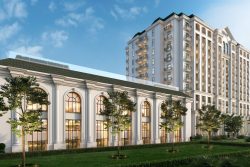George Orwell would have recognised the character of the world which is creeping up on us. We are losing our privacy and surrendering some of our personal freedom to the state, almost without being aware of it. Technology is the new tool of autocrats, and nowhere has it been deployed to greater effect than in China. It is, as one New York Times correspondent described it, governance by data and governance by mass surveillance. Even democracies have to be careful; the new surveillance techniques will make possible greater authoritarianism.
While it is well known that the Chinese authorities use these techniques against the Uighurs in Xinjiang province, in fact such surveillance exists at all levels throughout the country. CNET reports that China’s facial recognition system logs nearly every single citizen in the country, with a vast network of cameras. In addition, facial recognition technology is employed to track Uighurs outside their home province, the first example, to quote the NYT, of a “government intentionally using artificial intelligence for racial profiling.” The cameras, said the paper, look for Uighurs based on appearance, and keep records of their activities and where they go, for the purposes of review.
China has not been reticent about selling or providing the technology to other countries, because economic benefit apart, perhaps it considers it would be facilitating a more illiberal model elsewhere with which it would feel greater comfort than with democracy. Whatever the case, two years ago the Carnegie Endowment for Inter-national Peace found that China supplied the technology to 63 countries (that number has probably increased since then), while its nearest competitor was Japan’s NEC Corporation, which sold to 14.
And one of the countries which has received Chinese surveillance technology is Guyana. The Safe City project was first introduced by the coalition government, and it is one of the very few programmes which has been continued and expanded by the current one. Traditional CCTV cameras record what is happening at a location, and if a crime, say, is committed there, the footage can be retrieved later provided it has not yet been erased. Face recognition technology in contrast records in real time with the images being transmitted to a command centre.
One version of this allows facial images from the cameras to be compared against databases administered by the Guyana Police Force and international security agencies with which Guyana has bilateral relations. This generated a storm of criticism in 2019, which prompted the government to assure citizens that this version of face recognition would only be installed at ports of entry, but not on the streets.
The number of cameras on the streets prior to this government acceding to office was 119, and their features were reported to include video monitoring systems to assist in the deployment and tracking of law enforcement officers, remote tracking, a facial tracking system, real time facial recognition and a licence plate location history search system. There are also two systems which can be mounted on vehicles.
The cameras cover sections of Georgetown and the East Bank and are operational 24 hours a day. The command centre built by Huawei and opened in 2019, employs 25 agents. As for privacy concerns, former Minister of Public Security Khemraj Ramjattan assured the public that intelligence obtained via the system was not being “used against” any citizen. “If you feel we are doing some intelligence to use against you, no, we are not going to do that,” he was quoted as saying. In this country that kind of reassurance from a government official – any government official from any governing party – is no reassurance at all.
A government press release at the time guaranteed that the Safe City programme operated on an independent government-owned fibre optic network managed by the National Data Management Authority, an agency of the Ministry of Public Telecommunications. It had no points of entry or gateways for any third party, whether individuals or companies, it said. Again, that will not necessarily be enough to persuade everyone of its autonomy and independence from political influence.
The argument in favour of these intrusive systems in western democracies relates to controlling crime. Even there, however, there is a considerable amount of debate as to whether face recognition systems in any form are acceptable given that they constitute invasions of privacy. In large cities, without the link to databases of any kind whereby specific individuals could be identified and tracked, there would be less of a privacy issue than in small ones, although well-known persons would inevitably be easily identified.
Guyana has a very small population and no large cities. As such, many persons will be easily identified by the agents sitting in the command centre, and can possibly be tracked at least partly by following their progress past the cameras. In such a politically sensitive state, will everyone really be confident that somehow information about the activities of a given prominent figure or a critic or a group of critics will not trickle out to the powers that be? And that the only matter the agents will be concerned with will be crime?
Last week, President Irfaan Ali said that speed cameras would be introduced on the new highway to be built between Mandela Avenue and Diamond, following which the scheme would likely be expanded to other parts of the country. There is nothing wrong with that; in fact it would be a vast improvement on what obtains at present with the traffic police and their tickets. But last month he also announced plans to expand the surveillance programme countrywide. “…Nationally we are going to have a Safe Country programme. We are going to have the entire country connected on the CCTV cameras so that all of the country will be [under] the watch by the relevant authorities so that we can be proactive in crime fighting,” he said.
He claimed that this was because the Safe City project had produced results in the fight against crime, although he supplied no specific instances of this, or any indication that it related to the locales covered by the cameras. He merely referred to the overall decrease in serious crime which, it might be noted, could be accounted for by any number of factors.
Citizens might be justified in wondering whether we are going to have a Safe County programme or a Surveilled Country programme. In any event, before the government goes ploughing ahead with the face recognition element in the expanded programme, perhaps it would like to give a breakdown of how many crimes have been prevented or criminals caught as a consequence of these cameras being in place.
Under normal circumstances the opposition might have been chary about the face recognition technology, but then they were the ones to introduce it and defend it, so there is little they can say now. Most citizens probably know very little about Safe City solutions, other than that the project is intended to prevent crime and catch criminals, and who would oppose that? If they were told, however, that it would enable the government potentially to watch them all the time once they exited their front doors, they might be less enthusiastic.




